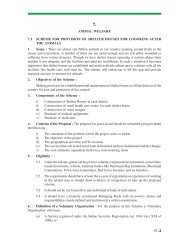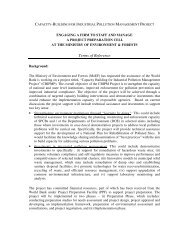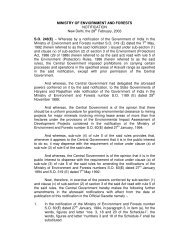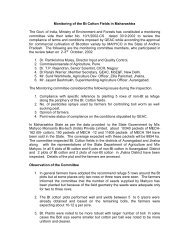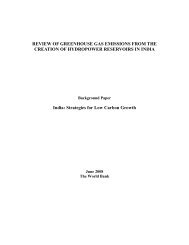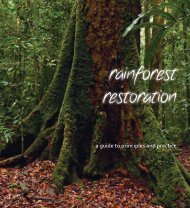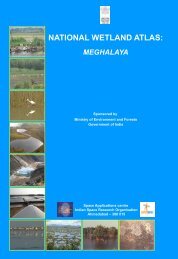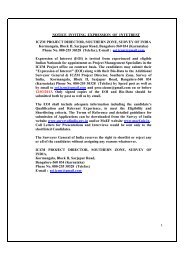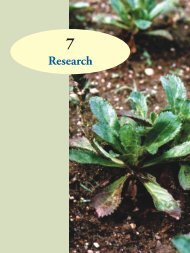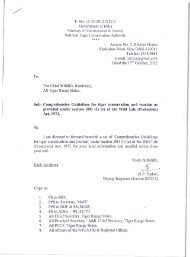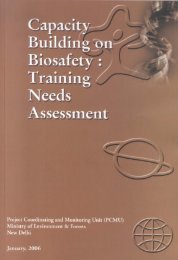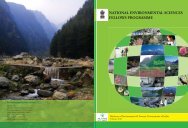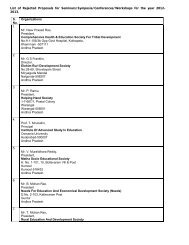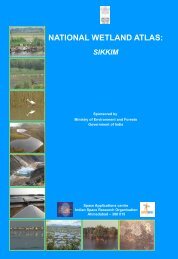Wetlands Atlas - Ministry of Environment and Forests
Wetlands Atlas - Ministry of Environment and Forests
Wetlands Atlas - Ministry of Environment and Forests
Create successful ePaper yourself
Turn your PDF publications into a flip-book with our unique Google optimized e-Paper software.
2.0 NATIONAL WETLAND INVENTORY AND ASSESSMENT (NWIA) PROJECT<br />
Realising the importance <strong>of</strong> many small wetl<strong>and</strong>s that dot the Indian l<strong>and</strong>scape, it has been unanimously felt<br />
that inventory <strong>of</strong> the wetl<strong>and</strong>s at 1:50,000 scale is essential. The task seemed challenging in view <strong>of</strong> the vast<br />
geographic area <strong>of</strong> our country enriched with diverse wetl<strong>and</strong> classes. Space Applications Centre with its<br />
experience in use <strong>of</strong> RS <strong>and</strong> GIS in the field <strong>of</strong> wetl<strong>and</strong> studies, took up this challenging task. This is further<br />
strengthened by the fact that guidelines to create geospatial framework, codification scheme, data base<br />
structure etc. for natural resources survey has already been well established by the initiative <strong>of</strong> ISRO under<br />
various national level mapping projects. With this strength, the National Wetl<strong>and</strong> Inventory <strong>and</strong> Assessment<br />
(NWIA) project was formulated by SAC, which was approved <strong>and</strong> funded by MoEF.<br />
The main objectives <strong>of</strong> the project are:<br />
• To map the wetl<strong>and</strong>s on 1:50000 scale using two date (pre <strong>and</strong> post monsoon) IRS LISS III digital data<br />
following a st<strong>and</strong>ard wetl<strong>and</strong> classification system.<br />
• Integration <strong>of</strong> ancillary theme layers ( road, rail, settlements, drainage, administrative boundaries)<br />
• Creation <strong>of</strong> a seamless database <strong>of</strong> the states <strong>and</strong> country in GIS environment.<br />
• Preparation <strong>of</strong> State-wise wetl<strong>and</strong> atlases.<br />
The project was initiated during 2007. The first task was to have a classification system that can be used by<br />
different types <strong>of</strong> users while amenable to database. An expert/peer group was formed <strong>and</strong> the peer review<br />
was held at SAC on June 2007 where wetl<strong>and</strong> experts <strong>and</strong> database experts participated <strong>and</strong> finalized the<br />
classification system. It was agreed to follow the classification system that has been used for the earlier<br />
project <strong>of</strong> 1:250,000 scale, with slight modification. Modified National Wetl<strong>and</strong> Classification system for<br />
wetl<strong>and</strong> delineation <strong>and</strong> mapping comprise 19 wetl<strong>and</strong> classes which are organized under a Level III<br />
hierarchical system. The definition <strong>of</strong> each wetl<strong>and</strong> class <strong>and</strong> its interpretation method was finalized.<br />
The technical/procedure manual was prepared as the st<strong>and</strong>ard guideline for the project execution across the<br />
country (Garg <strong>and</strong> Patel, 2007). The present atlas is part <strong>of</strong> the national level data base <strong>and</strong> deals with the<br />
state <strong>of</strong> Rajasthan.<br />
2.1 Wetl<strong>and</strong> Classification System<br />
In the present project, Modified National Wetl<strong>and</strong> Classification system is used for wetl<strong>and</strong> delineation <strong>and</strong><br />
mapping comprising 19 wetl<strong>and</strong> classes which are organized under a Level III hierarchical system (Table 1).<br />
Level one has two classes: inl<strong>and</strong> <strong>and</strong> coastal, these are further bifurcated into two categories as: natural <strong>and</strong><br />
man-made under which the 19 wetl<strong>and</strong> classes are suitably placed. Two-date data pertaining to pre-monsoon<br />
<strong>and</strong> post-monsoon was used to confirm the classes. <strong>Wetl<strong>and</strong>s</strong> put to agriculture use in any <strong>of</strong> the two dates<br />
are not included as wetl<strong>and</strong> class. Definitions <strong>of</strong> wetl<strong>and</strong> categories used in the project is given in Annexure-I.<br />
2.2 Spatial Framework <strong>and</strong> GIS Database<br />
The National Spatial Framework (NSF) has been used as the spatial framework to create the database<br />
(Anon. 2005a). The database design <strong>and</strong> creation st<strong>and</strong>ard suggested by NRDB/NNRMS guidelines is<br />
followed. Feature codification scheme for every input element has been worked out keeping in view the<br />
nationwide administrative as well as natural hierarchy (State-district- within the feature class for each <strong>of</strong> the<br />
theme. All data elements are given a unique name, which are self explanatory with short forms.<br />
Following wetl<strong>and</strong> layers are generated for each inl<strong>and</strong> wetl<strong>and</strong>:<br />
• Wetl<strong>and</strong> extent: As wetl<strong>and</strong>s encompass open water, aquatic vegetation (submerged, floating <strong>and</strong><br />
emergent), the wetl<strong>and</strong> boundary should ideally include all these. Satellite image gives a clear signature<br />
<strong>of</strong> the wetl<strong>and</strong> extent from the imprint <strong>of</strong> water spread over the years.<br />
• Water spread: There are two layers representing post-monsoon <strong>and</strong> pre-monsoon water spread during<br />
the year <strong>of</strong> data acquisition.<br />
• Aquatic vegetation spread: The presence <strong>of</strong> vegetation in wetl<strong>and</strong>s provides information about its<br />
trophic condition. As is known, aquatic vegetation is <strong>of</strong> four types, viz. benthic, submerged, floating<br />
5



